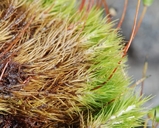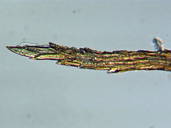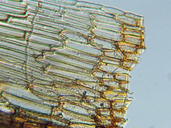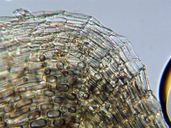- Map Distribution
- Description
- eFlora Distribution
- Illustrations
- Cal Photos images
- Elevation by latitude plot
MAP CONTROLS
1. You can change the display of the base map and layers by clicking on the layer control box in the upper right-hand corner.
2. California county polygons can be turned off and on in the layer control box.
3. Filling of Jepson subdivision polygons can be turned off and on in the layer control box.
Database links
UC Specimens in the University and Jepson Herbaria Public Portal
Specimens of Bartramia ithyphylla in the Consortium of North American Bryophyte Herbaria portal (CNABH)
Bartramia ithyphylla
Plants erect in glaucous green to yellow green or deep green wefts, to 3 cm high. Leaves to 4 mm long, subulate to linear-subulate from an obovate base well-demarcated by shoulders which define a 60 degree angle with the leaf mid-line. Leaf base occupying 1/4–1/6 of leaf length, erect and sheathing, 2.5–3.5: 1. Subula spreading to erect spreading when moist, little changed upon drying, not keeled. Lamina of subula in cross-section mostly 2–3 -stratose but with a single marginal unistratose row. Laminal cells rectangular, 3–6: 1, prorate at distal end or at both ends on both the ab- and adaxial surfaces, moderately thick walled but without pitting, to 6 µm wide. Median cells of leaf base unistratose, narrowly rectangular, 6–8: 1, smooth and hyaline, thin walled without pitting, to 14 µm wide. Cells of alar angles essentially undifferentiated. Leaf margins not decurrent, plane throughout, entire on base but regularly serrate from the shoulders to the apex. Costa not tapered, filling 1/2–1/3 of leaf base, but with outline obscured by leaf thickness in subula, percurrent, without abaxial toothing. Costa cross-section flattened, thickest at mid line and gradually tapered to margin, with strong ab- and adaxial stereid bands, and with 1–2 layers of guide cells. Axillary hairs inserted at immediate leaf insertion, to 250 µm, to 8 cells long with the cells similar or with a poorly demarcated basal brown cell. Rhizoids restricted to macronematal area, to 20 µm in basal diameter, forming a dense tomentum on old stems, papillose and red-brown, repeatedly branched with the ultimate divisions dichotomous. Macronemata to 100 µm long, mostly 1–2: 1. Stem cross-section rounded pentagonal, without a hyaloderm, and with only 1–2 layers of red-brown and somewhat pachydermous outer cortical cells surrounding a large group of hyaline and leptodermous inner corticals and a strongly developed central strand.
Synoicous with perichaetial bracts loosely erect but otherwise not strongly differentiated from adjacent vegetative leaves. Seta yellow brown to brown, smooth, geniculate near the apex, to 10 mm long. Urn to 2.5 mm long, oblong to nearly spherical, inclined and sulcate to irregularly wrinkled, not at all strumose. Operculum short conic. Annulus absent. Exothecial cells at capsule mouth mostly strongly reddened, differentiated in up to 4 rows, to 25 µm broad, transversely elongate, 0.5–0.8: 1. Exothecial cells at middle of urn quadrate to hexagonal, mostly isodiametric with angular lumens and small corner thickenings, to 50 µm broad. Stomata phaneroporous, poorly developed and often annular and unicellular, restricted to neck of urn. Exostome inserted below mouth, pale to brown, to 200 µm long, undivided, smooth to lightly papillose. Endostome segments free or adherent to exostome teeth, arising from a rather low basal membrane, smooth to lightly papillose, shorter than the exostome, mostly without cilia. Calyptra cucullate, mostly shed before capsule maturity. Spores papillose, reniform, to 30 µm in greatest diameter.
Vouchers: Alpine Co.: Winnemucca Lake, Eldorado National Forest, Norris 71271; Fresno Co.: Taboose Pass Trail, headwaters of South Fork Kings River, Kings Canyon National Park, Shevock 13852; Mono Co.: Tioga Junction Campground, about 2.5 miles north of Tioga Pass on Highway 120, Inyo National Forest, Norris 48346; Siskiyou Co.: South Fork Lakes west of Callahan, Klamath National Forest, Norris 76910; Tuolumne Co.: Lower Young Lake, Yosemite National Park, Messick 677 (UC).
Literature: Crum and Anderson 1981; Flowers 1973; Koch 1950a, 1958; Lawton 1971; Lesquereux 1868; McGrew 1976; Showers 1982; Spjut 1971; Watson 1880.
Geographic subdivisions for Bartramia ithyphylla: CaR, NW, SN, SNE. |
Illustration References: Malcolm et al. 2009 p. 195; Crum and Anderson 1981; Flowers 1973; Ignatov and Ignatova 2003; Lawton 1971; Sharp et al. 1994; Smith 1978.














